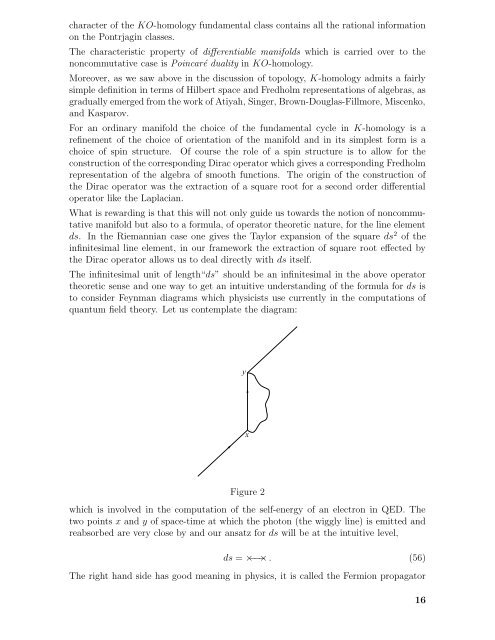Alain Connes (pdf)
Alain Connes (pdf)
Alain Connes (pdf)
Create successful ePaper yourself
Turn your PDF publications into a flip-book with our unique Google optimized e-Paper software.
character of the KO-homology fundamental class contains all the rational information<br />
on the Pontrjagin classes.<br />
The characteristic property of differentiable manifolds which is carried over to the<br />
noncommutative case is Poincaré duality in KO-homology.<br />
Moreover, as we saw above in the discussion of topology, K-homology admits a fairly<br />
simple definition in terms of Hilbert space and Fredholm representations of algebras, as<br />
gradually emerged from the work of Atiyah, Singer, Brown-Douglas-Fillmore, Miscenko,<br />
and Kasparov.<br />
For an ordinary manifold the choice of the fundamental cycle in K-homology is a<br />
refinement of the choice of orientation of the manifold and in its simplest form is a<br />
choice of spin structure. Of course the role of a spin structure is to allow for the<br />
construction of the corresponding Dirac operator which gives a corresponding Fredholm<br />
representation of the algebra of smooth functions. The origin of the construction of<br />
the Dirac operator was the extraction of a square root for a second order differential<br />
operator like the Laplacian.<br />
What is rewarding is that this will not only guide us towards the notion of noncommutative<br />
manifold but also to a formula, of operator theoretic nature, for the line element<br />
ds. In the Riemannian case one gives the Taylor expansion of the square ds 2 of the<br />
infinitesimal line element, in our framework the extraction of square root effected by<br />
the Dirac operator allows us to deal directly with ds itself.<br />
The infinitesimal unit of length“ds” should be an infinitesimal in the above operator<br />
theoretic sense and one way to get an intuitive understanding of the formula for ds is<br />
to consider Feynman diagrams which physicists use currently in the computations of<br />
quantum field theory. Let us contemplate the diagram:<br />
y<br />
<br />
x<br />
<br />
Figure 2<br />
which is involved in the computation of the self-energy of an electron in QED. The<br />
two points x and y of space-time at which the photon (the wiggly line) is emitted and<br />
reabsorbed are very close by and our ansatz for ds will be at the intuitive level,<br />
ds = ×−−−× . (56)<br />
The right hand side has good meaning in physics, it is called the Fermion propagator<br />
16

















